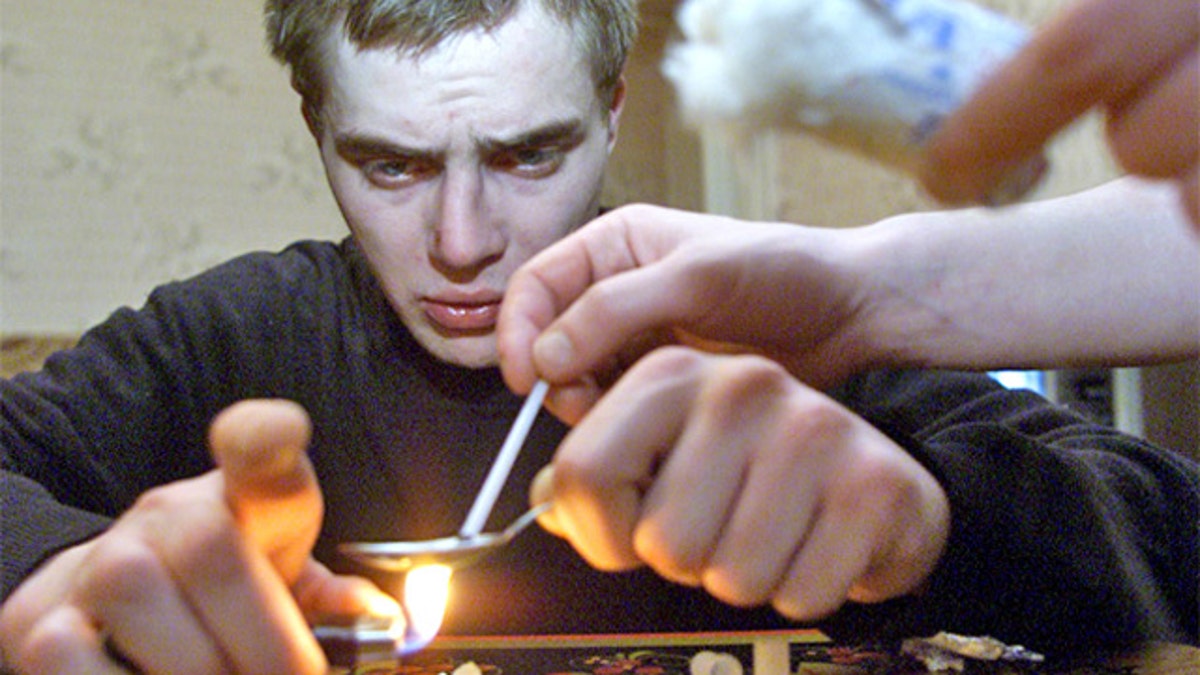
A man prepares heroin in Zhukovsky, Russia, near Moscow. To produce krokodil, which has a comparable effect to heroin but is much cheaper to make, users mix codeine with gasoline, paint thinner, iodine, hydrochloric acid and red phosphorous. (Reuters)
EXCLUSIVE: A new designer drug called krokodil -- a derivative of morphine that can turn an addict's skin greenish, scaly and cause it to rot away -- is being eyed by officials at the Drug Enforcement Administration, FoxNews.com has learned.
"We're looking at it overseas, but we have not seen it yet in the U.S.," DEA spokesman Rusty Payne told FoxNews.com. "But we would not be surprised when that day comes."
Thus far, users of krokodil -- or desomorphine -- have only been found in large numbers in Russia, where 65 million doses of the opiate have been seized during the first three months of this year alone, Russia's Federal Drug Control Service told Time.
To produce the potentially deadly drug, which has a comparable effect to heroin but is much cheaper to make, users mix codeine with gasoline, paint thinner, iodine, hydrochloric acid and red phosphorous. Codeine, a controlled substance in the United States used to treat mild to moderate pain, is widely available over the counter in Russia.
In 2010, up to a million people, according to various estimates, were injecting the resulting substance into their veins in Russia, thus far the only country worldwide to see it grow into an epidemic, Time reports.
The drug's sinister nickname -- also known as crocodile -- refers to the greenish and scaly appearance of a user's skin at the site of injection as blood vessels rupture and cause surrounding tissues to die. According to reports, the drug first appeared in Siberia and parts of Russia around 2002, but has spread throughout the country in recent years.
Officials at the Washington-based National Institute on Drug Abuse told FoxNews.com that they had not heard of the drug prior to Tuesday's inquiry by FoxNews.com.
Dr. Ellen Marmur, chief of dermatological and cosmetic surgery at the Mount Sinai Medical Center in New York City, told FoxNews.com she had never seen any cases involving krokodil, but said it reminded her of "skin popping," or when intravenous drug users inject a substance directly into their skin due to damaged veins.
"This looks to me a lot like skin popping, what drug users used to do back in the day with heroin and other drugs," Marmur said. "It just kills the skin, that's what you're seeing, big dead pieces of skin."
Those large pieces of dead skin are referred to as eschars, Marmur said, leaving the user prone to infection, amputation and other complications.
Marmur said she was concerned that the drug could eventually make its way into the United States.
"It's horrible," she continued. "These people are the ultimate in self-destructive drug addiction. Once you're an addict at this level, any rational thinking doesn't apply."
Dr. Lewis Nelson, a medical toxicologist at Bellevue Hospital Center in New York, said he doubts krokodil will reach the United States due to the availability of other cheap, powerful drugs such as black tar heroin and Oxycontin.
"It's not going to become a club drug, I can guarantee you that," he said.

